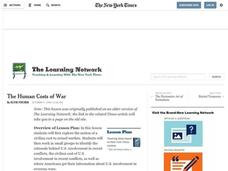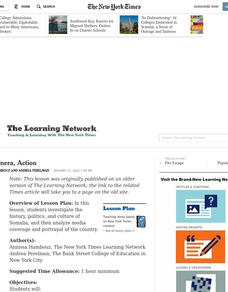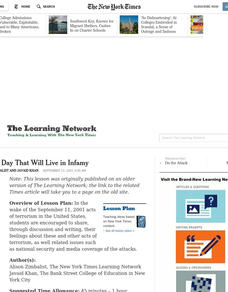Curated OER
Circle the Earth - Explore Surface Types on a Journey around Earth
Students use CERES percent coverage surface data with a world map in locating landmasses and bodies of water at Earth's Equator.
Curated OER
The President: Politician in Chieft
Learners explore the role of the U.S. President and the media coverage in presidential elections. They discuss what it means to be informed, the issues they consider most important, and reflect on what they learned from their interviews....
Curated OER
Journalists Under Fire
Learners examine journalism in extreme conditions. In this war-zone journalism lesson, students research media coverage of Vietnam, Grenada, the Gulf War, and military actions in Somalia and Kosovo. Learners compare coverage in the past...
Curated OER
The Eye of the Beholder: A Media Literacy Activity
Students explore the impact the news media have on shaping perceptions and opinions in general and in their coverage of the presidential campaign.
Curated OER
Justice For All?
Students study about President Bush's nomination of federal appeals court judge John G. Roberts to the Supreme Court. They compare coverage of the nomination in different sections and articles in The New York Times.
Curated OER
Supplementary Angles
Students develop an understanding of the journalistic concept of the "news angle," by examining the newspaper coverage of an airplane disaster.
Curated OER
Seasonal Cloud Cover Variations
Students, in groups, access data from the NASA website Live Access Server regarding seasonal cloud coverage and the type of clouds that make up the coverage. They graph the data and make correlations between types, seasons and percentages.
Curated OER
Make It or Break It
Students study about "breaking news" by analyzing the New York Times' coverage of the July 2006 bombing of seven commuter trains in Mumbai, India. They write their own breaking news stories for homework.
Curated OER
The Human Costs of War
Young scholars explore the concept of civilian cost to armed warfare. They explore the role of the military, civilians and of press coverage during armed conflicts, creating posters illustrating their research on post-WW II military...
Curated OER
Consider the Source
Students explain how to critically compare news reporting from around the world, focusing on coverage of the Taliban regime. They compare and contrast television and print media reporting on the issue.
Curated OER
Life, Camera, Action
Students investigate the history, politics and culture of Somalia. They analyze media coverage and portrayal of the country. They focus on the role of media in reporting on Somalia and the current debate over the film Black Hawk Down.
Curated OER
Another Day That Will Live In Infamy
Students are encouraged to share, through discussion and writing, their feelings about these and other acts of terrorism, as well related issues such as national security and media coverage of the attacks.
Curated OER
Crime Time
Students examine fundamentals of American criminal justice by analyzing each step of the criminal process. They follow the process of a well-known or publicized criminal case in The New York Times, and keep a journal of its newspaper...
Curated OER
In Harm's Way: Natural Disasters in My Community
Eleventh graders research and debate natural disasters that have occurred in their community. They assess whether these natural disasters were avoidable or were accidents. They investigate the extent of insurance coverage for disasters.
Curated OER
What's Your Angle?
Students examine The New York Times' coverage of immigrants' rights in order to gain an understanding of how different news angles function. They assess the angles of different news media outlets, such as television, radio, and Internet...
Curated OER
A History of Conflict
Students explore issues contributing to current tensions between Pakistan and India, drawing conclusions about how the conflict came about and where it may be heading. They Participate in an in-class "diplomacy summit"; create a...
Michigan State University
Researching and Compiling Survey Information
Bring Internet research and social issues to your language arts class in this activity. After investigating the topic "Media Violence and How It Affects Teenagers" on the Internet, middle schoolers work in groups to compile their...
Media Smarts
Defining Popular Culture
What part does media play in creating, defining, and perpetuating popular culture? High schoolers chart their encounters with fads, trends, and icons and reflect on the media's influence on popular culture.
PBS
What Is Newsworthy?
What is news? What is newsworthy? Who decides and what criteria do they use? Introduce young journalists to the basics of reporting with this media literacy lesson.
Advocates for Human Rights
Migrants in the Media
Class members examine two documents—The Universal Declaration of Human Rights and The Rights of Migrants in the United States—and then use reports in the media to assess how well the US is doing in ensuring these rights.
iCivics
Lesson 3: Bias
How do journalists balance bias and ethical reporting? The final lesson in a series of five from iCivics examines the different types of bias and how they affect the news we read. Young reporters take to the Internet to find examples of...
Southern Poverty Law Center
Evaluating Online Sources
All sources are pretty much the same, right? If this is how your class views the sources they use for writing or research projects, present them with a media literacy lesson on smart source evaluation. Groups examine several articles,...
Southern Poverty Law Center
Analyzing How Words Communicate Bias
Words are powerful ... can your class choose them wisely? Scholars evaluate news articles to discover the concepts of tone, charge, and bias during a media literacy instructional activity. The resource focuses on recognizing implicit...
American Press Institute
Media Literacy: Where News Comes From
What actually happens at a press conference? Make sense of the mayhem with a mock press conference activity designed to promote media literacy. Individuals participate as either members of the press or the governor's office to examine...
Other popular searches
- Newspaper Coverage
- Media Coverage
- Cloud Coverage
- News Coverage
- Media Coverage in Elections
- Measuring Cloud Coverage
- Prescription Drug Coverage
- Iraqi War Coverage
- Types of Writing Coverage

























